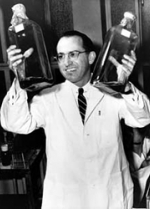Dr. Jonas E. Salk

For developing a vaccine for polio, Salk received The American Legion's Distinguished Service medal in 1955. In his absence, 6-year-old Mary Kosloski accepted the award for the vaccine bearing Salk's name.
The poster child for the March of Dimes, Koslowski was diagnosed with the dreaded disease at only 5 months old. "I would like to thank all of The American Legion in behalf of the March of Dimes," she told delegates.
Her gratitude was echoed by Raymond H. Barrows, executive director of the National Foundation for Infantile Paralysis and its March of Dimes campaign. Barrows also thanked "the many laymen, scientists and professional persons, tens of thousands of American Legionnaires among them, who have contributed their knowledge, skills and support to the development of a potent, safe and effective vaccine that will in a large degree prevent the crippling effects of infantile paralysis."
Flu, the common cold, cancer and AIDS were some of Salk's areas of study. But his war on polio turned him into a worldwide celebrity. When news of the Salk polio vaccine became public in April 1955, Salk found he no longer had a private life.
Then a medical researcher at the University of Pittsburgh, Salk's discovery changed the world. But he wanted no part of a patent that would restrict production rights. He wanted everyone to benefit, for the least amount of cost.
The son of Russian-Jewish immigrants, Salk grew up in New York City and was the first in his family to attend college. He started studying law, but quickly changed to medicine and viral research.
Dedicated to research, he founded the Jonas Salk Institute for Biological Studies in 1963. Salk spent his final years researching an AIDS vaccine. He died in 1995, at 80.
For more on Salk, click here. (http://www.achievement.org/autodoc/printmember/sal0bio-1)
